Accepted Scientific Name: Coryphantha pulleineana (Backeb.) Glass
Cact. Suc. Mex. 13: 35. 1968
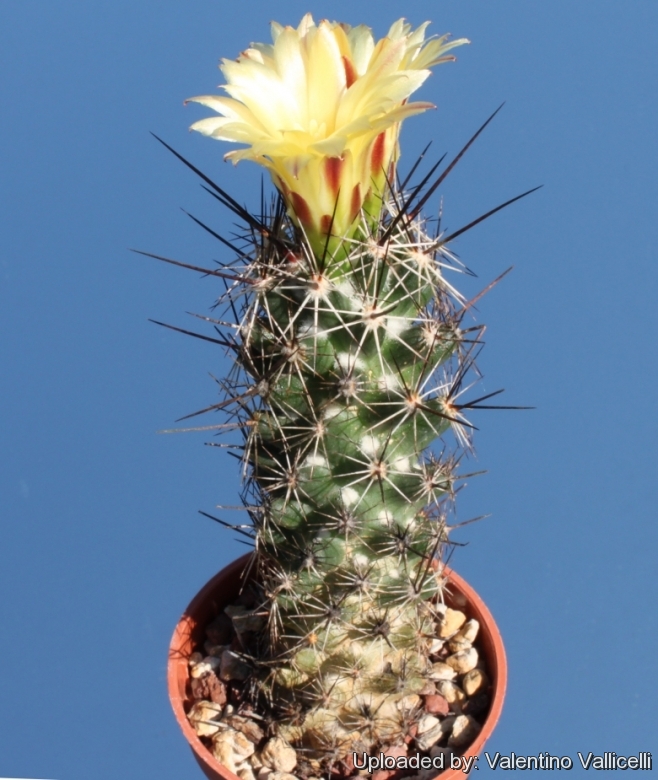
Neolloydia pulleineana (Coryphantha pulleineana) Photo by: Valentino Vallicelli
Origin and Habitat: Coryphantha pulleineanaSN|936]]SN|936]] is known from only two locations in Tamaulipas and northern San Luis Potosi, Mexico, where six localities are known (extent of occurrence approximately 2,500km2).
Type locality: Near Entronque Huizache, San Luis Potosi.
Altitude: 1200-1500 metres above sea level.
Habitat and Ecology: It is usually found on limestone hill slopes in xerophylous scrub, the plants are quite scattered and well hidden. Habitat destruction is a major threat mostly due to overgrazing goats but also due to some mining activities.
Synonyms:
Description: Coryphantha pulleineana is a distinctive tiny Coryphantha recognizable for the thin elongated stem, usually solitary, occasionally branching from below.
Stem: Somewhat cylindrical, dull grey-green plant to 20 cm long, 1,5-4,5 cm thick.
Roots: Very long fleshy tuberous roots
Tubercles: Pronounced roundish-conical to ovoid, ascending, up to 10 mm long, axils and furrows with white wool without glands.
Central spines: 3 or 5 much longer, straight, rigid, brownish to black up to 28 mm long.
Radial spines: 12-18 straight, unequal, grey-white with dark tips, 13-15 mm long. up to 1 cm long.
Blooming Habits: flowers up to 2,5 cm long, 3-4 cm in diameter, pale or bright yellow or orange-yellow.
Blooming season: Summer.
Fruits: Roundish, greenish, juicy.
Bibliography: Major references and further lectures
1) Dr. med. Reto F. Dicht, Adrian D. Lüthy “Coryphantha: Cacti of Mexico and Southern USA” Springer, 2005
2) Nathaniel Lord Britton, Joseph Nelson Rose “Cactaceae: Descriptions and Illustrations of Plants of the Cactus Family” Courier Dover Publications, 1963
3) Edward Anderson “The Cactus family” Timber Press, Incorporated, 2001
4) James Cullen, Sabina G. Knees, H. Suzanne Cubey "The European Garden Flora Flowering Plants: A Manual for the Identification of Plants Cultivated in Europe, Both Out-of-Doors and Under Glass" Cambridge University Press, 11/Aug/2011
5) David R Hunt; Nigel P Taylor; Graham Charles; International Cactaceae Systematics Group. "The New Cactus Lexicon" dh books, 2006
6) Clive Innes, Charles Glass “Cacti” Portland House, 01/May/1991
7) Clive Innes “Complete Handbook of Cacti and Succulents” Van Nostrand Reinhold Company, 01/Dec/1981
8) Gómez-Hinostrosa, C. & Hernández, H.M. 2013. Coryphantha pulleineana. In: IUCN 2013. "IUCN Red List of Threatened Species." Version 2013.2. <www.iucnredlist.org>. Downloaded on 22 March 2014.
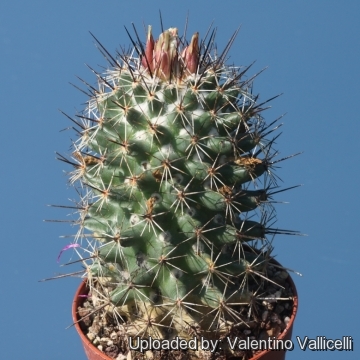 SB33 (Collector Steven Brack) Huizache, San Luis Potosi, Mexico. (Coryphantha pulleineana) Photo by: Valentino Vallicelli
SB33 (Collector Steven Brack) Huizache, San Luis Potosi, Mexico. (Coryphantha pulleineana) Photo by: Valentino Vallicelli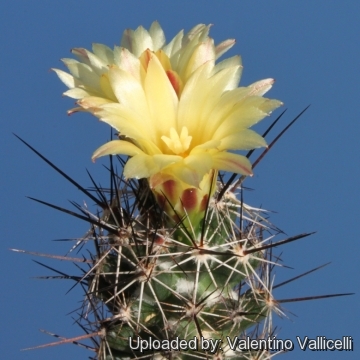 Neolloydia pulleineana (Coryphantha pulleineana) Photo by: Valentino Vallicelli
Neolloydia pulleineana (Coryphantha pulleineana) Photo by: Valentino Vallicelli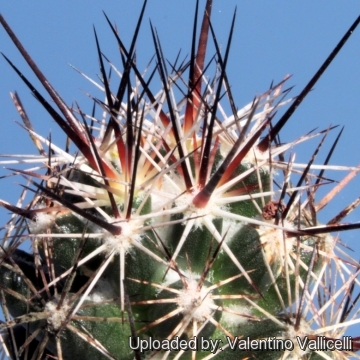 Neolloydia pulleineana (Coryphantha pulleineana) Photo by: Valentino Vallicelli
Neolloydia pulleineana (Coryphantha pulleineana) Photo by: Valentino Vallicelli Neolloydia pulleineana (Coryphantha pulleineana) Photo by: Valentino Vallicelli
Neolloydia pulleineana (Coryphantha pulleineana) Photo by: Valentino Vallicelli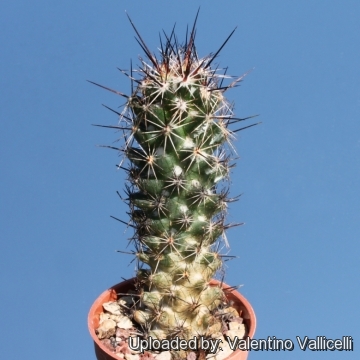 Neolloydia pulleineana (Coryphantha pulleineana) Photo by: Valentino Vallicelli
Neolloydia pulleineana (Coryphantha pulleineana) Photo by: Valentino VallicelliSend a photo of this plant.The gallery now contains thousands of pictures, however it is possible to do even more. We are, of course, seeking photos of species not yet shown in the gallery but not only that, we are also looking for better pictures than those already present.
Read More... Cultivation and Propagation: It is a summer-growing species of easy cultivation. It is sensitive to overwatering (rot prone) and slow-growing.
Soil: Grow it in an open sandy-gritty cactus compost.
Pots: It needs a relatively shallow pot to accommodate its fibrous roots and provide a very good drainage. They may stay in the same pot for many years.
Watering: Water in moderation, it prefer a completely dry place during winter. Mature individuals easily rot and die especially after planting so be extremely cautious with watering. Keep dry in winter or when night temperatures remain below 10° C. Water it less than average if in bigger pots.
Special need: Provide very good ventilation. Nearly all problems occur as a result of overwatering and poor ventilation, especially when weather conditions are dull and cool or very humid.
Fertilization: Feed them once during the growing season with a fertilizer specifically formulated for cactus and succulents (high potash fertilizer with a dilute low nitrogen), including all micro nutrients and trace elements diluted to ½ the strength recommended on the label. They thrive in poor soils and need a limited supplies of fertilizer to avoid the plants developing excess vegetation, which is easily attacked by fungal diseases.
Exposure: It will do its best with lots of sun and become stressed with inadequate light which could result in poor growth and unnatural shape.
Hardiness: It likes warmth (recommended minimum winter temperature 5° C) however plants kept perfectly dry can can survive low temperatures, approx. -5°, but for safe cultivation it is best to avoid freezing temperatures.
Use: It can be cultivated outdoors in raised beds, terraces if sheltered from winter rain.
Pests & diseases: These cacti may be attractive to a variety of insects, but plants in good condition should be nearly pest-free, particularly if they are grown in a mineral potting-mix, with good exposure and ventilation. Nonetheless, there are several pests to watch for:
- Red spiders: Red spiders may be effectively rubbed up by misting the plants from above.
- Mealy bugs: Mealy bugs occasionally develop aerial into the new leaves and flowers with disfiguring results, but the worst types develop underground on the roots and are invisible except by their effects.
- Scales, thrips and aphids: These insects are rarely a problem.
- Rot: Rot is only a minor problem if the plants are watered and “aired” correctly. If they are not, fungicides won't help all that much.
Propagation: Seeds. The seeds can be sown in pots of fine, well-drained sandy soil, any time during the spring when temperatures are warm. Cover the seeds with a fine layer of grit and water from below with a fungicide to prevent damping off. For the 1-2 weeks cover the pots with a sheet of glass/clear perspex to keep the humidity levels high. Remove the glass and replace it with light shade-cloth and mist once or twice a day for the next two weeks after which most seeds should have germinated. From then on mistings can be reduced to every second and then every third day as the little plants grow.
















